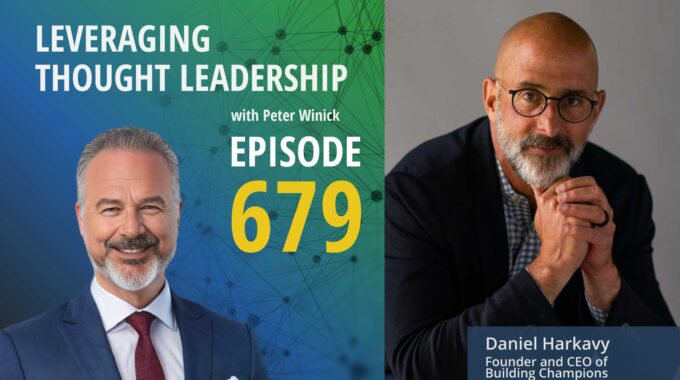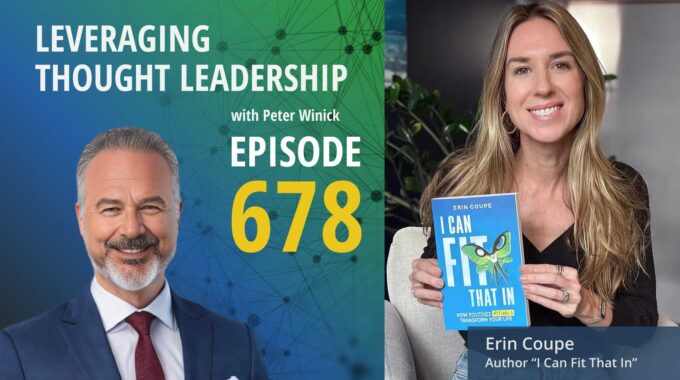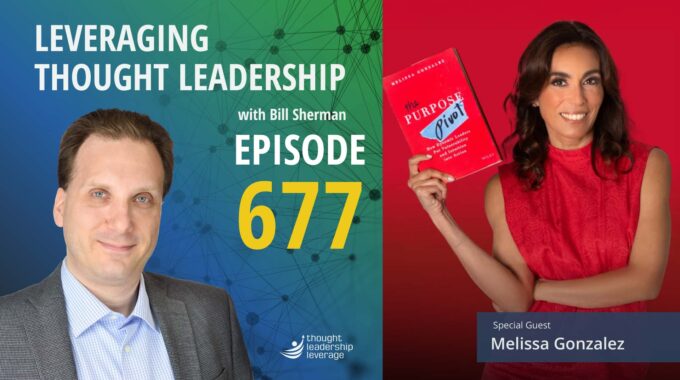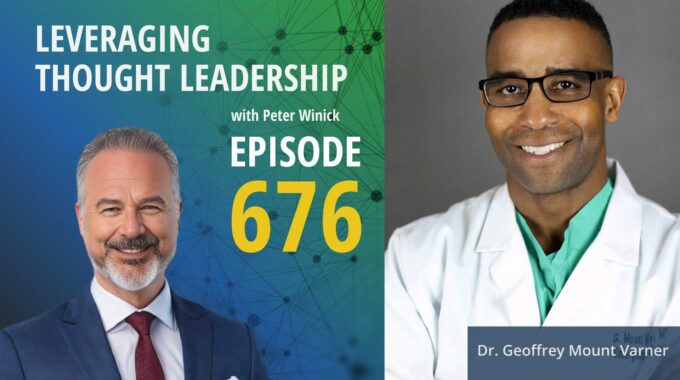A roadmap for leaders who want to multiply their impact — not their workload. This…
Build Influence Before the First Call | Jim Schleckser
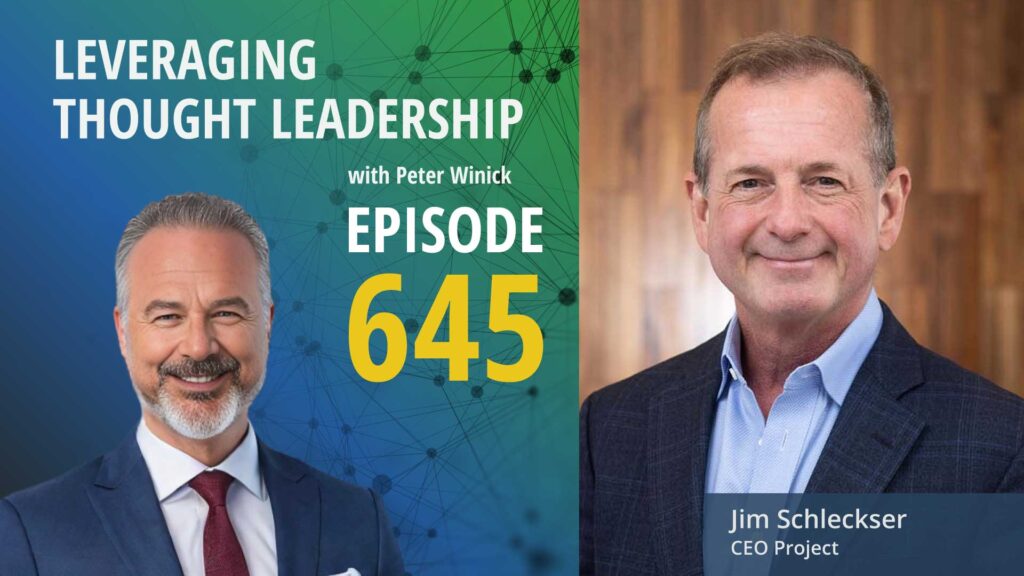
From Podcasts to Peer Groups—Strategies That Work
This episode explores how CEOs are leveraging thought leadership to drive growth, build trust, and deepen relationships—both inside and outside their organizations. It examines the value of books, podcasts, and curated content as strategic tools for influence, not just visibility. The conversation also highlights the evolving role of AI in content creation and the importance of human insight in maintaining authenticity and competitive advantage.
What if your next client already feels like they know you—before you’ve ever spoken a word?
This week on Leveraging Thought Leadership, Peter talks with Jim Schleckser, founder of The CEO Project, a peer advisory group for high-performing CEOs. Jim shares insights from advising over 125 CEOs across 40 states, leading organizations with revenues from $25 million to over $2 billion. His unique perspective offers a window into how top leaders are using thought leadership as both consumers and creators.
We dig into why CEOs crave curated content that helps them grow—and why books and podcasts still dominate their learning habits. Jim explains how the right idea, delivered through the right channel, can build trust and drive decisions long before the first handshake. We explore how CEOs and their teams are becoming more intentional about
content creation—not for vanity metrics, but to attract the right clients, partners, and talent.
Jim also unpacks the shifting role of AI in content development. As more companies turn to AI for marketing output, he challenges us to think deeper: What’s your human layer of insight that the algorithms can’t replicate?
This episode is packed with practical takeaways for CEOs, content creators, and thought leaders who want to build meaningful influence, not just volume.
Three Key Takeaways
Quality Over Quantity in Thought Leadership
CEOs aren’t looking for mass appeal—they want relevant insights from trusted sources. Thought leadership that resonates with a niche but high-value audience can drive business results far more effectively than chasing viral reach.
Books and Podcasts Still Matter
Despite the flood of digital content, CEOs continue to prioritize books and podcasts as their go-to learning tools. These formats allow for deeper engagement and often serve as catalysts for future business relationships.
AI Is a Tool, Not a Strategy
While AI can assist in generating content, it can’t replace the value of human insight. Leaders must use AI thoughtfully—adding expertise and perspective—to ensure their thought leadership remains authentic and impactful.
If you found Jim Schleckser’s insights on high-impact, CEO-focused thought leadership valuable, you’ll want to check out Episode 498 with Will Milano. Will shares how organizations can turn their senior leaders and subject-matter experts into trusted voices of authority—without relying solely on the CEO. Together, these episodes explore how to scale thought leadership, deepen trust, and focus on quality over quantity. Don’t miss it!
Transcript
Peter Winick And welcome, welcome, this is Peter Winick. I’m the founder and CEO at Thought Leadership Leverage and you’re joining us on the podcast which is Leveraging Thought Leadership. Today my guest is Dr. Jim Schleckser. He is the founder of the CEO Project which is a CEO peer group and he’s got an interesting perspective and focal point based on the work that he does. So Jim, welcome aboard today.
Jim Schleckser Thanks for having me, Peter. I’d appreciate it.
Peter Winick Yeah, so let me ask you this. Your work is CEO advisory, CEO peer groups, et cetera. So you’re swimming all day with CEOs, not literally swimming unless… Well, I have swum at various points, but not every day. That’s an occasional occurrence. Better than sinking with CEOs. Well, yeah. And how many CEOs are in the CEO project community?
Jim Schleckser We work with about 125 CEOs, all industries, really all over the United States. I think last time I counted, we were in 38 or 40 states, something like that. And what’s the revenue range on the company? We get interested around 20, 25 million dollars of revenue because we think that’s when you move from sort of CEO and number one salesperson, number one marketer, engineer, whatever, and our largest firms we work with are kind of two and a half, three billion dollars. So we got a pretty big range, but what we do to keep it interesting is we cluster them with other CEOs in their size range. So you’re not gonna be running a $200 million company sitting next to a guy running a five million dollar scrap yard going, I don’t know what this person can do to help me, right? It’s gonna be other people in your size range and they go, oh yeah, yeah, I had that problem a year ago, here’s how I solved it. So that’s what’s powerful about what we do.
Peter Winick So based on your vantage point then, give me your thoughts or what you’re seeing in the marketplace relative to how CEOs are using thought leadership. And I’ll split that in two. One is How are they taking in ideas and thought leadership and such so that they can be better leaders, so that can grow their companies faster and learn what they need to learn? And then B is a separate use case. What are they doing to develop thought leadership for their own personal brands, for the company, et cetera? So you wanna touch on that?
Jim Schleckser So the big thing I’ve seen lately, and let me start with CEOs are readers, most of them actually, and a surprising percentage compared to the general population. And so books work. And, you know, my standard. When I read a book or when I wrote my books was, you know, if they get two, three, four good ideas out of the book, it’s a win. So they’re not looking for a hundred good ideas. They need four from this one, four from that one, five from that and so forth. So reading is a big area of content digestion, but interestingly enough, podcasts have really become a big deal either during exercise or commute time or just hanging out time. So they are very big consumers of business podcasts to get ideas, to get new thinking, to hear what other people are doing. So those are the two channels I’ve seen, and particularly with the growth in the podcast one over the last 10 years or so, it’s become super, super important. And in fact, when they get together, you’ll hear, hey, have you listened to this one or that one or the other one? And frankly, that’s how I’ve gotten some of the podcasts I listen to by hearing what other CEOs are listening to. And they’re usually pretty on point in terms of ones that are worth listening to and which are not.
Peter Winick So those were two. I think that’s interesting from a… Leverage standpoint because oftentimes authors and podcasters are too obsessed with how many viewers how many listeners how many books that I sell whatever it’s like, you know what a handful of CEOs as an example that embrace your ideas. Those are the ones that can bring you in to speak, advise, consult, license your work.
Jim Schleckser That’s right. That you’re a you know There was a guy that did he’s passed, but he wrote a book on Self-publishing of books and that point and I think her acquaintance name. Anyway, he’s past on But his idea was you need a treasure map around your book. And the idea is, you’re not going to get rich on a book, like only a few people actually get rich on books. But what you can get rich on is all the stuff around the book. To your point, speaking, consulting, you know, peer groups, selling product, whatever it is, same thing’s true, I think in a podcast, if you look at the profile of podcast listeners, how many people have 100,000 listeners? It is really thin air, but you know, a couple of thousands of exactly the right people that could buy your product service, speech consulting. That’s what’s interesting. I actually had one guy that said, I actually don’t care if anybody listens to the podcast of just a couple have the right People listen, I’m good. And so yeah, I think they have to flip your thinking from volume, quality over quantity, when you’re there.
Peter Winick And then I think that’s that moving the focus away from volume. You know, one way to do that is to keep the constraint on the focus because it’s easier to say, let me broaden the conversation. Let me broaden in the conversation, whatever. And you say, okay, wait, if, if my, you know, target market is a billion-dollar CEO, then would this be of interest to that person or not?
Jim Schleckser Yep.
Peter Winick Yep. So let’s go to the other side of the question, which is, what are you seeing? Because there’s a lot of talk and a lot Of organizations are trying to embrace this thought leadership thing from the standpoint of how do I stand out from the competition? How do I show the marketplace we’re smart? How do we use this as a way to elevate the brand, attract new clients, et cetera? So what are you seeing in that space?
Jim Schleckser Yeah, so I mean, this is all part of a greater content strategy, really for search capability, because the way people find potential partners is they search. And so if you dominate the landscape for a particular set of ideas or set of words, You’re going to be found more, more readily. And that can back up into what should I be talking about from a thought leadership point of view to attract people to the organization. So I think most CES I bump into are a little hesitant to be the lightning rod for their company. It’s funny, you know, they’re a little more humble than that. Now there are some that are out there and they’re big and they’re promoting and they want,.
Peter Winick Well, stay there for a minute. Cause I think there’s, I think that’s true. And I think it’s also a misperception from this standpoint. If I’m a CEO,.
Jim Schleckser I am.
Peter Winick Right. And I’m thinking, okay, you know what? The thought leadership would be a good thing for us to invest into whatever the objective is, elevate the brand, attract new clients, stand up from the competition, et cetera. The default is, Oh, do I really want to be the guy or the gal representing all?
Jim Schleckser I think those are two different issues. I think the first is to understand. Is this a wise investment of the firm’s resources to achieve the objective at hand? And then number two is the who.
Peter Winick So in a lot of our work, we’re trying to think about, well, how do you spread that, right? How do you look inside your organization and say, well, you know what, Jim’s a really good speaker, but he’s in accounting and so-and-so is a good researcher and this one’s got some really good ideas, but maybe English isn’t the first language, like how do you develop the capabilities in your organization? So it’s a, it’s an individual case. It’s an organizational capability, not an individual burden.
Jim Schleckser And I think that that’s absolutely right. And if you look at like the big consulting firms, they’re great at this, they’ve got 30 people, a hundred people writing really high quality stuff. But the idea that Is it worthwhile? Yes. Because if you’re going to be found, you have to own the content space that causes people to find your firm. Like when they’ve got your problem, you should be the first one they find when they go search, that is how they find it. So thought leadership in your area. So people find you absolutely important. I think delegating it out and having people do it is interesting. Funny enough, I think there is a balance of, should it be an organizational capability, or is it particularly when you’re a little smaller? Is it interesting to put a name face personality to it? So they’re attracted a bit to the personality as well. So I think when you’re a little smaller, having a personality element in the content strategy makes more sense. When you get bigger, you know, really big, it should be, it should be distributed competency.
Peter Winick Yeah, no, I, I think that’s right. I think, I that’s true. And it depends, right? It’s not applicable across every industry. This works really well. High tech. Services, financial services, etc. If I was selling, you know, wheat by the bushel, not so much probably, right? Well, but I’ve seen people do it in like, irrigation for crops, they had some really cool technology and crop irrigation and they became a leader in irrigation, like, I wouldn’t be real excited about that. But for them, it was awesome. And so same thing for their clients, they really wanted to learn more and be better. And it did crop yields. So they were the irrigation guys, you know,
Peter Winick If you’re enjoying this episode of Leveraging Thought Leadership. Please make sure to subscribe. If you’d like to help spread the word about our podcast, please leave a five-star review at ratethispodcast.com/LTL, and share it with your friends. We’re available on Apple Podcasts and on all major listening apps, as well as at thoughtleadershipleverage.com/podcast.
Peter Winick Well, I think I think the other thing to think about is, it’s also a great way to develop a porn relationship. So you’ve got a great podcast, right? You’re talking like I’m like I am. I would imagine an outcome of the podcast is not just people listening to you that you want to listen, but some of the people you have on and guest become friends, colleagues, clients, referral sources, etc, etc. And that is in service of the development of some thought leadership together.
Jim Schleckser Well, and you know, if you think about marketing is sort of softening the ground before you build the actual relationship. The number of people I’ve, we brought on to other like conversations or workshops or what and they go, Oh, I love your podcast. I listen to it all the time or I’ve read your book and I give it to my whole executive team. They’re like, I need to do business with this person. Right? If they like my content that much, I should be working with them somehow. So I love when that starts to happen that I have never talked to this human being. And yet I’m already in relationship with them because of the book.
Peter Winick Yeah, You know, it’s an interesting phenomenon. You know, you’re having a conversation with someone. There’s sort of two early conversations with someone that might be a client. First one is sort of traditional. You’ve got to sort of, there’s an educational phase. You’ve gotta teach them what you do and how you do it and why you’re a better choice and I’m not saying it’s a sales conversation, but there’s a change of information that needs to go on and it’s, it’s not all that exciting and it’s on all that fun, et cetera. It’s what we do, right? Not the best way. The other way is when someone comes to you and says, Hey, Jim, you know what? Wow! I’m a big fan, I’ve read your book, I’ve been listening to your podcast for two years, and now I wanna become part of the community. You’re like, bang, okay, we’re starting on third base here.
Jim Schleckser Absolutely, it’s wonderful. And when they, it feels like they already have a relationship with you, because they do through your ideas, even though you may never have spoken to them. Yeah, and this is part of why I love the audio book. You listen to me talk for five hours, and then you meet me, you feel like you know me. Because it’s like, I’ve had this guy’s wooden voice in my ears for hours of driving or whatever. Same thing with the podcast, you know, different than just reading the book, you actually get a sense for the individual and like, okay, they’re smart or they’re quick or they are whatever that makes me want to work with them and that’s quite a becoming.
Peter Winick I think the other piece is they kind of get your ideas, your style, whatever. And if they didn’t enjoy it, if they don’t like it, if they did appreciate it, they wouldn’t be there. So there is a self-selection piece. Because not everybody’s for everybody, right? And that’s okay. Like if they don’t, you get your, I don’t think peer groups are a good idea. Okay, well, then what are you calling me for?
Jim Schleckser Right?
Peter Winick Like, but that’s valuable, too. Right? As a D select to you know.
Jim Schleckser I have a friend is an insurance. He says the best answer you can give me as a yes. The second best answer is a quick no. Yeah, I’m all over the quick. No, like I am not for you and you are not for me done. Goodbye. And there was nothing wrong with that. There’s like seven point something billion people that I’m not the right guy for, right?
Peter Winick So that’s okay. That’s our guy.
Jim Schleckser Exactly. I think it’s some, some, you know, when you get the podcast, do some CEOs do hesitate? Should I be the voice? Yeah. Do I have a team that’s the voice I seen like Ram, I listen to Ramsey sometimes and he has a team of people that are personalities that he’s developed over time. But in the beginning it was just him, you know, for years probably.
Peter Winick Right, it is also an opportunity to retrain and attract talent, right?
Jim Schleckser So I’ve seen organizations where they never realize that so-and-so maybe does improv on the weekends or has no back for the stage or, and it’s like, wow, but we only saw you as an analyst or a researcher for that role is. And now we’re giving you a platform to be better at what we want you to do on the job and get more intrinsic satisfaction from the fact that there’s this other capability that you’ve got. Yeah, I love that. Look at that. It sounds like everybody should run a talent show and anybody who’s decent, you go, how’d you like to join the podcast?
Peter Winick Well, it is shocking. I think in my line of work, how many folks had some sort of theater background, whether in high school, college or whatever, or improv or standup or something, right? And then.
Jim Schleckser You know, I was a drama kid.
Peter Winick Right, right, right. And I’m not going to ask you to do like sing La Cage or anything, but, uh, but there’s something about that, right? Like, you know, that the stage presence, the communication skills, the ability to connect with people that doesn’t leave someone you might have to say, okay, now I’m now I am adulting, right that stage and become the next, you know, whatever, but how do I use some of those capabilities? And that’s fun when you find, you know, when you add, add those dimensions to the role that you have. Any, any other things that you’re seeing in the marketplace relative to creation consumption, discussions around thought, like, are you doing a lot of discussions in the peer-to-peer groups around books and ideas that people are sharing?
Jim Schleckser Or, um, right now there’s a huge threat of conversation around AI and where to, what are the use cases for AI? Here’s just the funniest thing I’ve observed. People use an AI to write articles and content content for their website. Now hopefully a human looks at it before you post it, but Just think about the loop though. This is what’s just wild. You know, a machine is writing content. So other search engine machines can find the content and hand it to the human. I’m like, Whoa, we’re a little meta here at this point of machines talking to machines, but, um, there are so many, that is a big, big theme of how do I, how do keep up with the information availability and, and, uh, how does my organization keep up the information capability? And I’d actually say there’s such a wash. Of content available. Like, how do I sort through what’s really important? And before you’d say, we’re all on the same basis. There’s a billion pieces of information we can never read at all. We get what we get. Now you go, well, with AI, maybe I could access those billion pieces and figure out what’s important, and I need to do it before my competitor does it, or they’re gonna gain competitive advantage on me. So the ability of AI to extract key information from these scads and scads of information that’s available to us. Has become a really interesting leverage point because they’re afraid their competitor figures it out before they do. So that’s become very important.
Peter Winick And it’s a content question. It really is. It’s a constant question.
Jim Schleckser When I think, you know, everyone’s, I don’t wanna say struggling with, but figuring out how to, right? There was the first group of Luddites that said, oh, then it’ll never work. I was like, okay, great. You go make your buggy whips and we’ll see how that works out, whatever.
Peter Winick Then I think we’re at the point now. Am I using AI for input or is it a shortcut for output? Right. So the output stuff, I mean, how many articles have you read on LinkedIn or something, go, that’s just crap like that.
Jim Schleckser Like there’s nothing to that. That’s just, I maintain, I can tell when it’s written by AI nowadays. It’s just very stilted. And maybe there’s a place for that. I look at that as the equivalent of like the airline magazine level of content or the magazine in the doctor’s office that’s seven years old that you pick up because.
Peter Winick There’s nothing else to do.
Jim Schleckser Oh, come on. I was a big fan of highlights when I was, you know,.
Peter Winick I think so that the output stuff, you got to be careful when it’s direct to output the AI because people are smarter than that. But I think those that are doing it well and creatively and are creating value, it’s just another input. You’ve got the world’s greatest research assistant at your fingertips that you probably couldn’t afford before. And now What I care about is, okay, Jim, you’re an expert on CEOs on high-growth companies, so you got some input from AI. Great, whether I care, that’s how you got it or not. What is the insight that you’re adding to that, and what are you bringing to the conversation? Because I respect you and your thoughts, and I love that you are getting input from a broader array, a broader place than you physically or cognitively could have in the past.
Jim Schleckser Yeah, I mean, I think when you’re editing stuff that comes out of AI, you if you’re not adding content that it didn’t find, then you’re not, you know, that’s a problem, you really should go, Okay, that was a good start. If we missed this whole theme, we missed this thread, we got to add this, this isn’t quite right. And then you’ve actually had a starting place. And I turned into something interesting at that point.
Peter Winick Or it’s content marketing, right? If you go to AI and say, Oh, give me you know. Create an ad that gives me three reasons why new mom should, uh, buy this guy for ash cream. Fine. I can get rid of some more copy editors. If I had an ad agency, that’s fine. And if I was a copy editor and ad agency not adding value, I’d really be worried about my livelihood right.
Jim Schleckser Oh, well, if you can’t write better copy than an AI system, then you got a problem on your hands. So, I mean, because like I said, I’ve read, I had a marketing person that was using it a lot. They go, look, you can’t, you can’t just give me AI output. This is not acceptable. I mean, I can tell when I read it. So go work on it and then come back and talk to me.
Peter Winick So any other thoughts, words of wisdom?
Jim Schleckser Um, you know, I think one of the things that we forget, and this is not content that you can get reading it’s travel. Travel is so mind-expanding for both people who work for you and CIs CEOs that you’ve got to get your butt off the, off the sofa and go travel. And I think we got shut down a little bit with, uh, with COVID and whatnot, but you gotta get out there and go to travel. Cause there are so many different ways problems are solved and you’re never going to read about them. You got to go see them and experience them. So I’m, I’m a huge travel fan as a way to expand your brain and expand your thinking and, and frankly go Maybe we don’t have all the answers in Ohio. You know, maybe somebody else has got some answers. We ought to be thinking about. So huge fan of travel is a way to improve your inputs as a CEO or any leader to just make you better, make you humble, make your broadened.
Peter Winick So, yeah, I love that. Well, thank you, Jim. This has been great. I appreciate your time and I appreciate your ideas. Thank you.
Peter Winick To learn more about Thought Leadership Leverage, please visit our website at ThoughtLeadershipLeverage.com. To reach me directly, feel free to email me at peter at Thought Leadership leverage.com and please subscribe to Leveraging Thought Leadership on iTunes or your favorite podcast app to get your weekly episode automatically.


